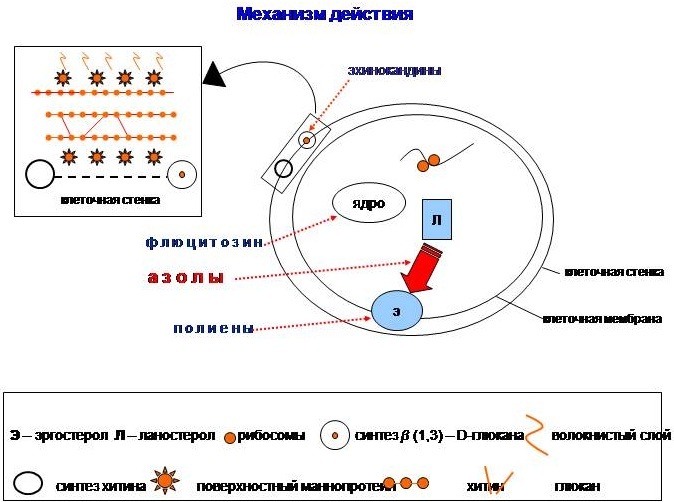Content
- What is polymyalgia rheumatica?
- The reasons for the development of the disease
- Etiological conditions for the development of the disease, predisposing factors
- Symptoms
- Sensations and physiological symptoms
- Signs of damage to the musculoskeletal system
- Laboratory signs of inflammation
- How is polymyalgia rheumatica related to other medical conditions?
- Diagnostics
- Laboratory Methods
- Instrumental methods
- Treatment
- Taking glucocorticoids (Prednisone, Prednisolone, Metiprednisolone, Deflazacort)
- Genetically engineered biological drugs (Infliximab, Etanercept)
- Exercise therapy (exercise complexes)
- Possible complications during treatment with glucocorticoids
- Forecasts
- Video about polymyalgia rheumatica
Polymyalgia rheumatica is a pathology, characterized by the occurrence of muscle pain. The disease is accompanied by symptoms characteristic of rheumatic diseases and requires compulsory treatment.
What is polymyalgia rheumatica?
The disease is a type of rheumatic (inflammatory) disorder. Its characteristic feature is the development of pain and stiffness in the shoulders, hips and neck. In most cases, the disease occurs in people over 50 years of age.
The reasons for the development of the disease
At the moment, the causes of the pathology have not been sufficiently studied. Studies suggest that the disease develops in patients with a genetic (hereditary) predisposition. It is also believed that pathology can be triggered by various infectious diseases - diverticulitis, pneumonia, Epstein-Barr viruses.
Other Supposed Causes:
- frequent stressful situations;
- hypothermia of the body;
- viral infections (adenovirus, parainfluenza);
- giant cell (temporal) arteritis.

To establish the exact cause, a comprehensive diagnostic study is required.
Etiological conditions for the development of the disease, predisposing factors
There are several major risk factors for the development of the disease. Thus, it takes into account age, gender and race. The disorder is more common in the elderly. The average figure is 73 years. It is noted that the pathology occurs 2 times more often in women than in men. The disease occurs predominantly in white people. The highest prevalence was recorded in the European northern regions.
Symptoms
Polymyalgia rheumatica (symptoms and treatment of the disease depend on the stage and degree of its severity) can be either pronounced or practically absent.
General symptoms:
- pain in various parts of the muscles;
- stiffness of movement, especially in the morning or in the absence of any activity;
- fever;
- weight loss (up to anorexia).
The patient has general weakness, fatigue and malaise.
Sensations and physiological symptoms
The onset of the disease is acute. In this case, a fever develops, and there are signs of toxic damage to the body.
The nature of the pains developing in the area of various muscle groups (neck and shoulder, spine, buttocks, belt) is pulling, cutting with slight twitching.
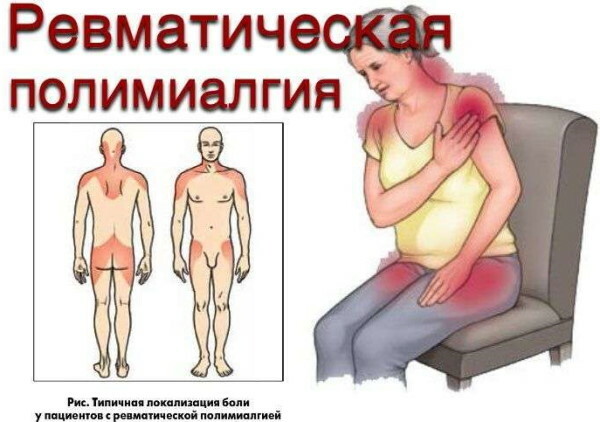
Painful sensations are complemented by stiffness in the joints and limited movement. At the same time, weather conditions do not affect the severity of the disease.
The patient is forced to limit the number of movements due to the increasing intensity of pain. The steps become short, mincing.
The apogee of symptoms occurs 1-2 months after the onset of the development of the disease. The pain syndrome becomes more pronounced and painful, which leads to even greater limitation of movement (up to complete immobilization).
The patient has signs of anorexia, weakness and fever.
Signs of damage to the musculoskeletal system
With the development or progression of pathology, damage to the musculoskeletal system is observed. The disorder can occur with symptoms of arthritis, which is a complication of the disease.
In this case, large joints are involved in the process, in the cavities of which an effusion can form. The pain syndrome in this case is less pronounced and occurs periodically.
Small joints of the hands are also affected, which is accompanied by the development of edema and the onset of carpal tunnel syndrome. In some cases, tendovaginitis may develop and flexion function may be impaired.
Laboratory signs of inflammation
Laboratory signs of the disease can be extensive. In most patients, an increase in the ESR level (over 40 mm / h) is observed.
There is also an increase in other indicators:
- C-reactive protein;
- fibrinogen;
- alpha 2 globulin;
- interleukin-6.
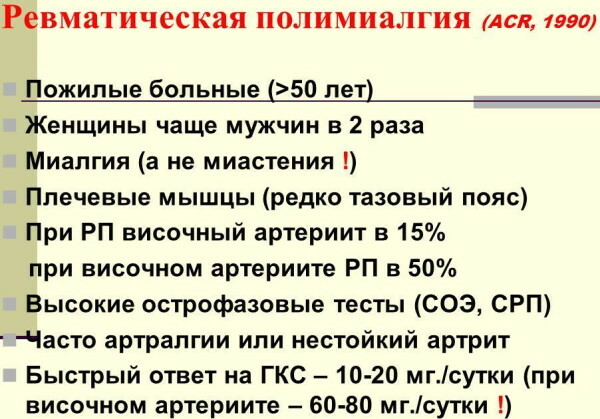 In this case, a decrease in hemoglobin occurs (up to 90 g / l). In this case, the pathology acquires a normochromic and normocytic character.
In this case, a decrease in hemoglobin occurs (up to 90 g / l). In this case, the pathology acquires a normochromic and normocytic character.
How is polymyalgia rheumatica related to other medical conditions?
Polymyalgia rheumatica (symptoms and treatment of the disorder may differ depending on the patient's age, stage development of the disease and other determining factors) is accompanied by the development of muscle pain and stiffness in the joints. However, in some cases, pathology can lead to the development of arthritis.
The process may involve other neighboring organs and systems. Thus, the disease often affects the blood vessels and leads to the development of temporal arteritis. The disorder can develop along with the underlying disease or precede it.
Diagnostics
Since the disease is difficult to diagnose on the basis of the existing symptoms and to separate it from other disorders, a number of studies are required.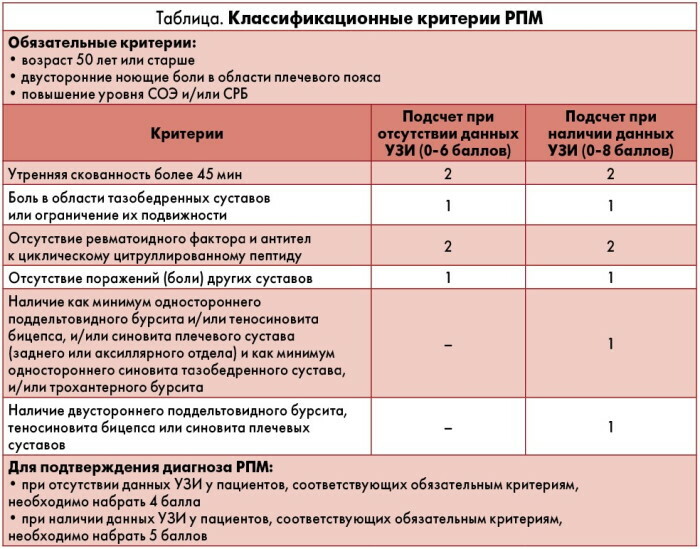
First of all, the specialist listens to the patient's complaints, conducts palpation (in most cases, ineffective), after which he prescribes various studies.
Laboratory Methods
Laboratory diagnostics allows you to determine the presence of inflammatory processes in the body and identify other possible disorders.
Research methods:
- general analysis of blood and urine;
- biochemical blood test - determination of the level of liver enzymes;
- enzyme immunoassay (ELISA) - usually negative;
- serological testing.
Much attention is paid to the biochemical study of blood, since an increase in the level of ESR, anemia or thrombocytosis is observed with the disease.
Instrumental methods
Instrumental research methods allow assessing the state of internal organs, lesions of the articular system, involvement of other systems in the process.
Diagnostics:
- Ultrasound - helps to establish the presence of concomitant disorders in the form of tendovaginitis, bursitis.
- MRI (magnetic resonance imaging) - is performed for the same purpose as ultrasound, but the technique is more effective for examining the hip and pelvic region.
- PET (Positron Emission Tomography) - is prescribed to detect vasculitis of large vessels and study various joints.
Additionally, other diagnostic methods can be used. If necessary, the patient can be referred to other highly specialized specialists.
Treatment
Treatment is selected individually according to the severity of symptoms, the severity of the pathology and other features of the disease and the patient's physiology. 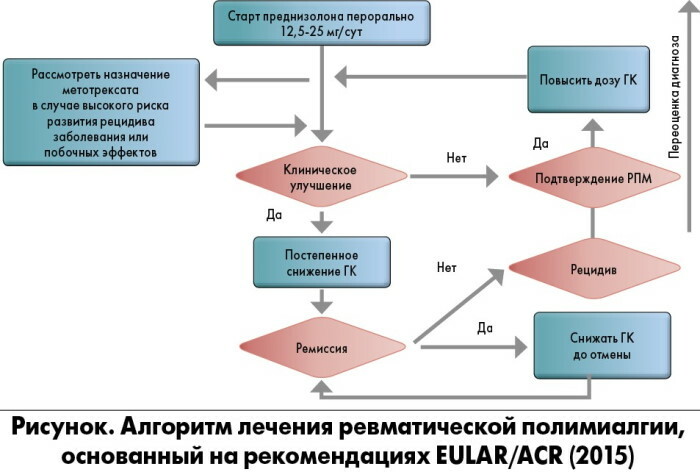 In this case, the therapy of polymyalgia rheumatica should be complex with the use of several effective techniques.
In this case, the therapy of polymyalgia rheumatica should be complex with the use of several effective techniques.
Taking glucocorticoids (Prednisone, Prednisolone, Metiprednisolone, Deflazacort)
The most effective therapy for the disorder is the use of glucocorticosteroid drugs, since they have a pronounced therapeutic effect.
| Product name | Dosage | Features of reception |
| Prednisone | 12.5-25 mg per day | It is taken at the beginning of treatment. Then the dose is gradually reduced to 10 mg within 1-2 months. With a good therapeutic effect, the dosage is reduced by every 1 mg once a month. The minimum duration of therapy is 1 year. |
| Prednisolone | 15 mg daily (starting dose) | Take the remedy for 2 months, gradually reducing the dosage. In the absence of exacerbations and relapses, the drug is canceled after 3-5 months of treatment. If Horton's disease develops, the starting dosage should be 40 to 60 mg. |
| Metiprednisolone | 60 mg per day | The drug is taken in this dosage for 3-4 weeks. With a pronounced therapeutic effect, the dosage is gradually reduced by 2-4 mg once every 2 weeks. Then the agent is used as a maintenance treatment at a dosage of 1-2 tablets per day. |
| Deflazacort | 0.9 mg / kg / day (6 to 90 mg) | Take the remedy for several months. Then (with a good therapeutic effect), the dosage is gradually reduced. The maintenance dosage should be no more than 6 mg per day. |
Genetically engineered biological drugs (Infliximab, Etanercept)
Genetically engineered drugs have been tested and can be used in the treatment of the disorder.
Infliximab is an anti-inflammatory agent and is used for infusion. It contains monoclonal antibodies with immunosuppressive effects.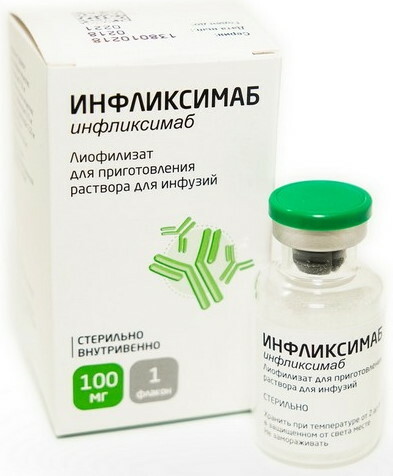
The initial dose of Inflixib is calculated based on the patient's body weight - 3 mg / kg / day. In severe conditions, the initial dosage may be increased to 5 mg. The duration of treatment is from 6 months to 1 year. Then the drug is canceled or transferred to a maintenance dose.
The second genetically engineered drug is called Etanercept. It is produced as a subcutaneous injection and has a pronounced anti-inflammatory and immunosuppressive effect.
Dosages: 25 mg 2 times a week. A single dosage is 50 mg. The duration of therapy is set by the doctor individually. According to the tests carried out, the result of treatment with a medication occurs after 2 weeks of its use.
Exercise therapy (exercise complexes)
Polymyalgia rheumatica (symptoms and treatment of the disorder are stage-by-stage and depend on the stage of the pathological process) can be successfully treated with the help of various exercises and gymnastics.
Exercise therapy (exercise therapy) is used to restore joint mobility, eliminate stiffness and increase the number of movements.
Exercise for the hands:
- Extend the brushes in front of you and turn them up and down alternately.
- Put your hands on a horizontal surface and raise them several times. Then the exercise is repeated only for the fingers.
- Extend hands clenched into fists and rotate them clockwise and counterclockwise.
- Place your elbows on a horizontal surface and squeeze your palms. Then you should part and bring your elbows together, without lifting them off the surface.
- A set of exercises is performed for each finger: up and down, left and right, circular movements.
- Each finger should touch the thumb.
- Take a soft ball and knead it in your hands. You can ride on the surface.
- Relax your palms and begin rotating movements with your hands.
- Rub your palms together.
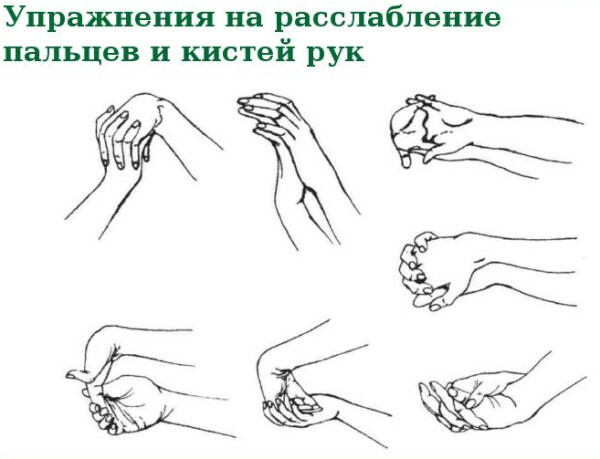
Shoulder exercises:
- Raise, lower your shoulders, make circular and rotational movements.
- Place your palms on your shoulders and try to push them forward.
- Take your elbows with your palms and lower and raise them.
- Lie on your back and stretch your arms forward. Raise and lower your arms several times.
- Put your hands on your lower back and try to slowly take them behind your back.
Exercises for the legs:
- Lie on your back and begin to bend your knees. In this case, the sole should not come off the floor.
- Perform the exercise "Bicycle" several times.
- Lying on your back, bend your knees and try to spread them to the sides and back.
- Bend your knee and begin to rotate.
- Lie on your back and spread your straight legs to the sides and back.
- Perform several circular movements with a straight leg.
Ankle exercises:
- Sit up straight and alternately bend and unbend your toes.
- Roll from heel to toe.
- Grab a handrail or other support and stand on your toes.
- Try to pick objects or things off the floor with your toes.
- Sitting on a chair, perform kneading and rolling movements with the feet of the legs. In this case, you must use a ball or ball.
- Walk on a stick, stepping on it with the middle of the sole.
- Make several circular movements with your feet.

During the exercise, you must try to keep the correct breathing rhythm. This will increase the effectiveness of the treatment complex and have a positive effect on the entire body.
Water treatments can also be carried out.
Patients with limited motor function are recommended to perform the following complex:
- Walking on a pond (pool) on bent or straight legs. In this case, it is recommended to spread your arms to the sides. The amount of water must be regulated.
- Perform circular and rotational movements with your legs, swing back and forth.
- Spread your legs wide and do squats. The back should be straight.
- The water level should be up to the neck. Spread your arms to the sides and make various movements with your arms, hands and shoulders.
The duration of the course is set individually by the attending physician. In some cases, treatment can last for months or even years.
Possible complications during treatment with glucocorticoids
Polymyalgia rheumatica (symptoms and treatment of the disease in all patients are similar, but have some differences) requires constant monitoring by a doctor, including adjusting the dosage of medicinal drugs.
Glucocorticosteroid drugs can lead to the development of various adverse reactions, so their intake should be strictly controlled by a specialist.
Side effects:
- ulcerative lesions of the stomach and duodenum (relapses or development of the disease);
- the formation of puffiness;
- diabetes;
- decreased immunity (poor and slow healing of injuries, wounds);
- increased risks of development or re-infection with various microorganisms - fungi, viruses, infectious and bacterial agents (including tuberculosis);
- osteoporosis;
- acne, acne, demodicosis;
- sexual dysfunctions - disruptions in the menstrual cycle, erectile dysfunction;
- increased blood pressure;
- the formation of blood clots in the veins and blood vessels (increased risks);
- disorders of the organs of vision - the development of cataracts, glaucoma;
- psychosomatic disorders (depressive conditions);
- growth retardation in children.
It should also be borne in mind that such drugs can lead to the so-called withdrawal syndrome (pseudosyndrome). In this case, the development of undesirable reactions from the underlying disease and other organs and systems is possible. In severe cases, the condition can lead to anaphylactic shock.
With the development of these symptoms, it is necessary to consult a specialist. If necessary, treatment can be canceled and resumed after elimination of side effects.
Forecasts
With timely and adequate treatment, the prognosis for recovery is favorable. In the absence of complications (giant cell arteritis), the pathology does not lead to disability and does not cause irreversible deforming changes in the limbs.
After the therapy, patients fully recover and return to full life.
If you develop any symptoms that indicate the development of polymyalgia rheumatica, you should immediately consult a doctor. A timely detected violation will allow you to choose an effective treatment and cope with the disease.
Video about polymyalgia rheumatica
Polymyalgia rheumatica:

